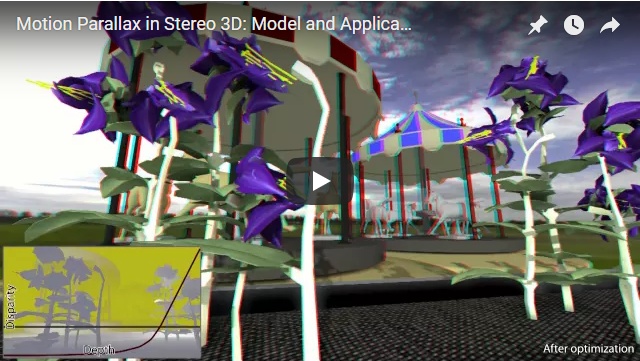
Motion Parallax in Stereo 3D: Model and Applications, SIGGRAPH Asia 2016
Motion Parallax in Stereo 3D: Model and Applications
Petr Kellnhofer1
Piotr Didyk1,2
Tobias Ritschel1,2,3
Belen Masia1,4
Karol Myszkowski1
Hans-Peter Seidel1
1 MPI Informatik
2 Saarland University, MMCI
3 University College London
4 Universidad de Zaragoza
Abstract
Binocular disparity is the main depth cue that makes stereoscopic images appear 3D. However, in many scenarios, the range of depth that can be reproduced by this cue is greatly limited and typically fixed due to constraints imposed by displays. For example, due to the low angular resolution of current automultiscopic screens, they can only reproduce a shallow depth range. In this work, we study the motion parallax cue, which is a relatively strong depth cue, and can be freely reproduced even on a 2D screen without any limits. We exploit the fact that in many practical scenarios, motion parallax provides sufficiently strong depth information that the presence of binocular depth cues can be reduced through aggressive disparity compression. To assess the strength of the effect we conduct psychovisual experiments that measure the influence of motion parallax on depth perception and relate it to the depth resulting from binocular disparity. Based on the measurements, we propose a joint disparity-parallax computational model that predicts apparent depth resulting from both cues. We demonstrate how this model can be applied in the context of stereo and multiscopic image processing, and propose new disparity manipulation techniques, which first quantify depth obtained from motion parallax, and then adjust binocular disparity information accordingly. This allows us to manipulate the disparity signal according to the strength of motion parallax to improve the overall depth reproduction. This technique is validated in additional experiments.
Video

Side-by-side version (may require Flash YouTube player - more info)
Downloads
|
Citation
Petr Kellnhofer, Piotr Didyk, Tobias Ritschel, Belen Masia, Karol Myszkowski, Hans-Peter Seidel
Motion Parallax in Stereo 3D: Model and Applications
ACM Transactions on Graphics 35(6) (Proc. SIGGRAPH Asia 2016, The Venetian Macao, Macao)
@article{Kellnhofer2016SGA,
author = {
Petr Kellnhofer and
Piotr Didyk and
Tobias Ritschel and
Belen Masia and
Karol Myszkowski and
Hans-Peter Seidel},
title = {Motion Parallax in Stereo 3D: Model and Applications},
journal = {ACM Transactions on Graphics (Proc. SIGGRAPH Asia 2016)},
year = {2016},
volume = {35},
number = {6},
doi = {10.1145/2980179.2980230},
url = {http://dx.doi.org/10.1145/2980179.2980230},
isbn = {978-1-4503-4514-9/16/12}
}
© 2016 The Authors. This is the author's version of the work. It is posted here for your personal use. Not for redistribution.
The definitive version was published in ACM Transactions on Graphics 35(6) (Proc. SIGGRAPH Asia 2016). http://dx.doi.org/10.1145/2980179.2980230
Acknowledgements
We would like to thank Junaid Ali, Sumit Shekhar, and the anonymous subjects who took part in our perceptual studies. This work was partly supported by the Max Planck cooperation program within the framework of the German pact for research and innovation (PFI).




